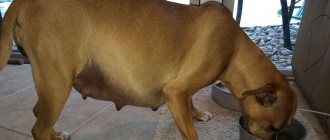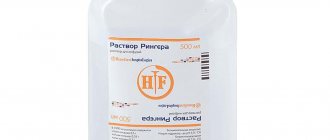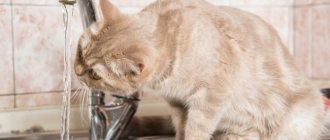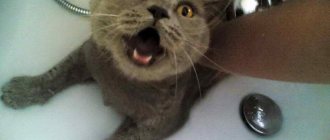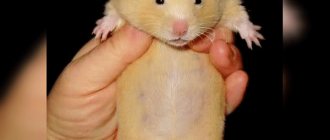Water consumption rate for dogs
An animal may have a single attack of thirst, for example, when the room is too hot, the dog begins to drink heavily.
This is quite acceptable , as the body is trying to cool down somehow. But if the animal begins to drink excessively constantly, the owner must take a closer look at the accompanying symptoms. Perhaps the reason is pathology.
Before deciding whether your dog drinks a lot, you need to know how much he should drink. It all depends on its weight: for each kg no more than 100 ml. If a dog weighs 5–10 kg, then it should drink no more than 0.5–1.0 liters per day. In this case, it is necessary to take into account not only clean water, but also all liquid dishes if the animal is on a natural diet.
A dog up to 10 kilograms drinks no more than a liter per day.
How to measure?
Before giving water to your dog, you need to measure its volume.
To determine how much your pet drinks, you need to take measurements.
When pouring water into a bowl, first measure its volume. When feeding, they also record how many ml of liquid meals were eaten per day. The readings are summed up and after that it is only possible to conclude whether the dog drinks a lot or whether this is normal for its weight. Don't forget to measure the water as you add it throughout the day.
Treatment of diseases that cause thirst in dogs
Depending on the diagnosis, the dog is prescribed a course of therapeutic treatment. In most cases it is treated conservatively. Urgent surgery is necessary only if purulent peritonitis develops as a complication of the closed form of pyometra, since otherwise death is a matter of several hours.
The range of medications prescribed to a dog for the treatment of pathology accompanied by polydipsia may include:
| Drug category | Examples of medicines | Indications for use (principle of action) |
| Diuretics | "Furosemide", "Torasemide", "Indapamide", "Triamterene", "Amiloride", "Hypothiazide" | They are the main component of therapy for kidney diseases: they increase urine production and accelerate the removal of toxins, dead bacteria and other products of the inflammatory process along with it. |
| Antibiotics (nitrofurans, uroseptics, sulfonamides, etc.) | “Furadonin”, “Furazonal”, “Furacilin”, “Furagin”, “Norsulfazol”, “Sulfadimethoxine”, “Sulfazin” | Mandatory when a bacterial infection is detected that has affected internal organs and led to an inflammatory process |
| Nonsteroidal anti-inflammatory drugs | "Carprofen", "Melixicam", "Firocoxib" | Used as an anti-inflammatory agent |
| Analgesics | "Cyston", "Analgin" | Reduce pain syndrome |
| Antispasmodics | "No-Shpa" | Facilitate the process of urination by relaxing tight muscles |
| Hemostatic drugs | "Vikasol" | Necessary when blood appears in the urine, which indicates the presence of ulcers or internal bleeding |
| Antihistamines | "Suprastin" | May be prescribed to reduce tissue swelling |
| Hepatoprotectors | "Divopride", "Hepatovet", "Api-San Hepatoject", "Arterium Tioprotectin", "Livofer Vet" | Used to maintain liver function, for example, sometimes prescribed as part of complex therapy for piroplasmosis |
| Antitumor drugs | "Cisplatin", "Doxorubicin", "Carboplatin" | Prevents the proliferation of malignant cells by destroying their DNA structure |
In some cases, the veterinarian uses a drug that combines several medicinal properties, specially selected for the treatment of a specific disease. For example, “Stop Cystitis” suspension or tablets are a complex medicine for cystitis that simultaneously meets the following characteristics:
- antiseptic;
- antimicrobial;
- antispasmodic;
- anti-inflammatory;
- diuretics (diuretics);
- saluretic (ensures the removal of sodium and chlorine salts from the body).
How to care for your dog during treatment
Additional care for a dog suffering from polydipsia should primarily be aimed at providing the animal with warmth and rest. Drafts and hypothermia traditionally increase the urge to urinate, which should never be allowed. A good emotional state is an important condition for a speedy recovery.
If the cause of the pathology is invasive, in some cases it may be necessary to isolate the dog, especially from other pets and children. A veterinarian must give such a recommendation.
Important! Clean water in sufficient quantities is a mandatory rule during the period of treatment and recovery.
Further, during treatment for involuntary urination, special diapers will help protect the animal. In pet stores today you can buy similar products specifically designed for dogs.
In general, diseases characterized by polydipsia do not require the use of a strict diet; the only caveat is that everything that can contribute to increased thirst must be excluded from the diet, primarily salty foods. However, if the cause of the problem is diabetes, the correct diet for the dog must be selected by a veterinarian. The general principle that should be followed for such a diagnosis is a minimum of carbohydrates and a maximum of protein.
Why does a dog drink a lot of water?
The simplest reasons for consuming excess fluid are heat indoors or outdoors, as well as greater physical stress on the animal during the warm season.
When switching to dry food, your dog will need more water.
If you feed an animal with over-salted food , then it will drink much more than it should. In cases where an animal is transferred from regular natural food to dry food, the pet will need additional liquid. This is a normal phenomenon, because previously the body received not only water, but also liquid from soups, broths, and cereals. And dry food does not contain moisture, so the bowl of water must be much larger than before or you will have to add water more often than usual.
Taking medications
In some cases, when the animal is prescribed a course of diuretics, or the pet is being treated with corticosteroids, excessive water consumption may occur.
During the period of taking medications, the dog needs more water.
This is completely normal and should not be limited. Anticonvulsant treatment also induces thirst in some animals.
How much water does a dog drink in normal condition?
When it comes to a dog’s increased fluid consumption, it is necessary, first of all, to define the concept of normal. There are no absolute figures on this matter, since the body’s need for water is determined by several factors, including:
- the size of the animal, and this relationship is a little more complex than a simple proportion, defined as the volume of liquid per kilogram of weight;
- age (puppies in their first year of life need approximately 2–3 times more water than adults);
- type of food (natural or wet food contains a large amount of water, but if the dog’s diet consists of dry food, the animal needs much more liquid);
- ambient temperature (dogs, like people, cool their bodies in the heat by secreting sweat; accordingly, at this time their need for fluid increases), etc.
Important! The average rate of water consumption for a dog is 40–60 ml per 1 kg of body weight, while a person, according to the official position of the World Health Organization, needs only 30 ml of liquid for the same unit of calculation. It is characteristic that the water content in the body of a human and a dog is the same - approximately 60%.
An interesting pattern is that the lower limit of the average accepted norm given above is suitable for representatives of large breeds, while the upper limit is valid for small and dwarf dogs. The fact is that the urine of small breeds of dogs contains an increased amount of acid, which is why such animals very often suffer from various pathologies of the genitourinary system. In order to reduce the acidity of urine and, accordingly, reduce the load on the kidneys, it is necessary to provide your pet with maximum fluid intake during the day.
The dog drinks a lot of water and goes to the toilet often
A dog may be thirsty due to an elevated temperature.
If the dog owner is convinced that the pet has no objective reasons for thirst, it is not hot outside, feeding occurs as usual and the animal has not been subjected to heavy stress and has not taken pills, the cause of thirst should be looked for in internal diseases:
- Any inflammatory process in the body is accompanied by an increase in temperature . You should measure the temperature and pay attention to the condition of the animal. Perhaps thirst is a consequence of the inflammatory process and elevated temperature.
- If , in addition to thirst, the dog also often asks to go to the toilet to urinate , it may have problems with the kidneys or urinary system. In this situation, it is necessary to pay attention to the dog’s behavior, whether urination is accompanied by pain, or whether there is bloody discharge in the urine. It is recommended to show the dog to a specialist, because kidney problems or cystitis are quite unpleasant diseases that can even lead to the death of the animal. For example, when the urinary ducts are blocked by stones. If urine has ceased to be excreted, the animal is lethargic, but still drinks a lot - urgently go to the veterinary clinic!
- If you notice that your dog is drinking and eating a lot, be sure to visit a veterinarian . He will suggest getting tested for diabetes. Unfortunately, this disease is affecting an increasing number of pets. Feeding buns, candies and other sweets leads to the progression of the disease. The dog begins to feel excessively thirsty and tries to drink a lot.
- Diabetes insipidus is also accompanied by water deficiency. The animal begins to drink excessively, the owner does not have time to add water to the drinking bowl.
- Thirst, refusal to eat, lethargy are obvious signs of pyometra. This disease is accompanied by a purulent inflammatory process in the uterus. In some cases, the presence of cancer may be present.
- With piroplasmosis , the animal also suffers from thirst, and the owner notices that the pet begins to drink too much water.
- Psychogenic polydipsia is accompanied by unprecedented thirst in the dog, the symptoms of which are difficult to ignore.
- Sometimes a spinal injury causes a dog to start drinking water excessively. Some dog breeds are prone to back and spinal injuries. For example, if the dachshund has become sad, and its gait is uncertain and weak, the nerve roots in the vertebrae may have become pinched. An indirect symptom of injury is an excessive need for water and frequent urination. In addition to dachshunds, such spinal problems occur in other breeds of dogs with elongated bodies, such as basset hounds.
Additional causes of thirst
If your pet has undergone castration surgery, then the excessive need for water is a consequence of hormonal changes in the body. Bitches during lactation may also experience an insatiable desire to drink water.
During lactation, dogs begin to drink water more often.
An incorrectly designed diet leads to the desire to drink large quantities of water. For example, a diet low in protein or salty fish dishes on the menu are the reasons why dogs start drinking water in huge doses.
What symptoms should you contact a veterinarian for?
The information above gives a very clear idea of when unusually strong thirst and frequent urination are alarming symptoms that require immediate examination. So, the dog should be taken to the veterinarian if the mentioned symptoms are accompanied by:
- increase or decrease in body temperature;
- urinary incontinence;
- signs of gastric upset - diarrhea, constipation;
- vomiting;
- pain during urination (the dog clearly wants to pee, but psychologically tries to delay this process; the upcoming pain frightens the animal);
- changes in the color of urine, the presence of any clots and impurities in it;
- any changes in the color and consistency of stool;
- painful condition of the peritoneum, swollen or sagging abdomen;
- cyanosis or yellowness of the mucous membranes of the oral cavity;
- the appearance of skin rashes;
- shortness of breath, difficulty breathing;
- lethargy, apathy, loss of appetite.
Important! The presence of any additional sign of ill health, in addition to polydipsia, is a clear reason to contact a veterinary clinic.
Treatment and assistance for your pet
Dog food should not be salty.
How can you help your dog if he drinks too much water? Here are the basic recommendations to help novice dog breeders:
- Checking dog food for salt . If foods are oversalted, you should change your diet and temporarily eliminate salt completely.
- By increasing the amount of protein foods in the menu , you can reduce water consumption.
- If thirst is caused by switching to dry food , just put a large bowl of water and periodically add liquid to it.
- If the owner suspects a dog has pyometra , it is necessary to contact a veterinarian. He will prescribe blood tests: general and biochemical, then send the animal for an ultrasound. Depending on the results obtained, treatment will be prescribed. In severe cases, this will be surgery with removal of the uterus and ovaries. Sometimes conservative treatment is prescribed. This will include antibiotic therapy, as well as the use of hormonal agents that affect the contraction of the uterus and the removal of any contents from it.
- Diabetes in animals is considered incurable , but the use of special medications can improve the condition and prolong the life of the pet. If your pet has diabetes, a diet will be recommended and insulin will be prescribed. The veterinarian will select the dose. It will depend on the constitutional characteristics of the dog and its physical activity. As for nutrition, it is best to switch the animal to ready-made food for diabetics. This will make it easier to control the nutrition process. Feed should be chosen only of high quality. If the doctor prescribes insulin, your pet will have to inject it at the same time every day. The doctor will select the dosage and tell you whether it is better to inject into the withers or chest. Special syringes are purchased at the pharmacy. You will also need to have a portable glucometer on hand to monitor your glucose levels. Sometimes, after taking insulin, an animal experiences an excessive drop in glucose levels, which can lead to the development of a hypoglycemic coma and can result in the death of the animal. If the level on the glucometer drops to 3 mmol/l, you should give the dog something sweet. For example, natural honey or dilute sugar in water and feed the animal with this syrup.
- If you have cystitis, give your dog as much water as possible ; you can brew bearberry and let your pet drink this decoction. Treatment with antibiotics is mandatory. In a veterinary clinic, the bladder is washed with disinfecting solutions. Suitable for this purpose: furatsilin, potassium permanganate, penicillin. In case of an infectious process, urosulfan, furadonin are prescribed, and if Pseudomonas aeruginosa is detected, gonocrine is prescribed. Cystenal helps relieve spasms and soreness. It is dripped onto sugar and given to the pet to eat.
Insipidal syndrome in children and adolescents. Part 3
Part 3. Read the beginning of the article in No. 6, 7, 2021.
Psychogenic (compulsive) polydipsia
Psychogenic (compulsive) polydipsia is currently a common pathology in patients with mental illness. Most often, psychogenic polydipsia is observed in patients with chronic schizophrenia, but can also be found in other mental illnesses associated with affective disorders, childhood psychosis, and personality disorders. Studies have shown that the disease may affect 6% to 20% of patients with mental changes. The etiology of the disease is not entirely clear [29].
The pathophysiological basis of water intoxication is impaired thirst control not caused by impaired production or release of ADH. The disease usually develops in three stages, starting with polydipsia and polyuria, followed by a period of hyponatremia (the kidneys lose the ability to excrete excess fluid as sodium excretion is reduced) and, finally, water intoxication, which can manifest as nausea, vomiting, delirium, ataxia, convulsions and even coma up to death. If a psychogenic cause of polydipsia is suspected, consultation with a psychiatrist is required.
Dipsogenic polydipsia is a disease characterized by frequent attacks of thirst with a decrease in the sensitivity threshold of osmotic receptors and suppression of ADH excretion. The term was coined in 1987 in a report of three patients without obvious visceral abnormalities or mental illness. The mechanism of dipsogenic diabetes insipidus is not entirely clear, so the existence of a separate disease is still disputed.
The condition is characterized by polydipsia and polyuria, constantly low urine osmolality (plasma osmolality is normal). Kidney function is preserved. Therefore, differential diagnosis of this disease is difficult.
However, it is important that in such patients, when fluid intake is limited, the state of health remains satisfactory and the amount of urine decreases, and its osmolality increases to physiological limits [30].
ADH drugs and thiazide diuretics should not be used, as they reduce water excretion without reducing its intake, and therefore can cause severe water intoxication. The doctor's main efforts should be aimed at correcting the patient's behavior and psyche in order to reduce fluid consumption.
Cerebral salt depletion syndrome
Cerebral salt wasting syndrome (CSW) is a disease characterized by increased sodium excretion due to intracranial disorders, leading to hyponatremia and decreased extracellular fluid volume.
The disorder was first described by Peters et al. in 1950, but the identification seven years later of the syndrome of inappropriate ADH secretion, which is also observed in disorders of the central nervous system, partly overshadowed the interest of researchers in this syndrome. Currently, some authors doubt the existence of CSW, but reports have been published confirming the existence of this phenomenon [31].
The mechanism that causes the development of CSW is still not fully understood. The disease manifests itself with primary natriuresis, which leads to hypovolemia and hyponatremia. It is believed that ANP, MNP and SNP may play a role in CSW. Moreover, MNP is the most likely cause of CSW [9].
Clinically, a patient with CSW experiences extreme thirst accompanied by polyuria due to osmotic natriuresis. At the same time, BCC decreases with the development of dehydration symptoms, serum osmolality decreases with increased urinary excretion of Na+ and Cl–.
Basic treatment for this syndrome is sodium administration and fluid replacement. Saline solution and 1.5% sodium chloride solution are used. The administration of mineralocorticoids—fludrocortisone (Cortineff), 0.1–0.2 mg orally 2 times a day—can reduce the volume of infusion therapy and accelerate the stabilization of BCC.
Progestin polyuria
Progestational polyuria that occurs during pregnancy is often temporary and is associated with excessive activity of a specific enzyme produced by the placenta, arginine aminopeptidase, which destroys AVP. The sensitivity threshold of osmotic receptors decreases, thirst increases. Pregnancy can worsen the course of previously diagnosed diabetes insipidus and increases the need for the hormone [32].
Functional polyuria
Functional polyuria is a consequence of the immaturity of the concentration mechanism of the kidneys in children of the first year of life and increased activity of the enzyme phosphodiesterase type 5. This disrupts the specific receptor connection with arginine vasopressin, resulting in low-density urine excretion.
Iatrogenic polyuria
Iatrogenic polyuria is a consequence of excessive or unjustified use of diuretics.
Clinical picture of ipsipidal syndrome
Symptoms of ipsipidal syndrome in most cases appear suddenly, but can develop gradually. Thus, central diabetes insipidus, which occurs as a result of injury or infection, usually manifests itself immediately after exposure to a pathogenic factor or after 2–4 weeks. Chronic infectious diseases cause CDI, usually after 1–2 years. NDI often manifests itself already in the first months of life with profuse diuresis that cannot be treated with ADH, a tendency to constipation, vomiting, and fever [33].
Ipsipidary syndrome is generally characterized by thirst. The amount of liquid drunk ranges from 3 to 20 liters, while small amounts of liquid, especially warm liquid, do not quench thirst.
Urine is excreted frequently and in large portions (500–800 ml), transparent, colorless, its specific gravity is very low (1000–1005), and does not contain protein or glucose. Children often experience bedwetting (enuresis) and nocturia.
The syndrome is accompanied by general dehydration (dry skin and mucous membranes, decreased salivation and sweating). Inadequate replacement of fluid loss is accompanied by general weakness, headaches, nausea, vomiting, fever, convulsions, tachycardia, increased hematocrit, collapsed states or psychomotor agitation.
When the thirst center is intact, there are no symptoms of dehydration, but they are especially characteristic of congenital NDI in children. Along with this, in this form of diabetes, sensitivity to SGAs may be partially preserved.
Constant overload with water leads to stretching of the stomach and its prolapse. The secretory function of the gastrointestinal tract decreases. Sleep is disturbed due to thirst and frequent urge to urinate. Persistent disturbances in the water-salt balance gradually lead to the development of malnutrition and delayed physical and mental development in childhood.
In the presence of pathology of the hypothalamic-pituitary region, symptoms associated with a secondary deficiency of hormones of the anterior pituitary gland and neurological disorders may be observed as a result of compression of brain structures by the tumor (narrowing or loss of visual fields).
Diagnostics
If the characteristic clinical picture described earlier is present, examination is recommended to exclude diabetes insipidus. If persistent hypotonic polyuria is detected: excretion of more than 3 liters or more than 40 ml per 1 kg of body weight of urine per day; urine osmolality is less than 300 mOsm/kg or the relative density of urine is less than 1005 g/l in a single portion or urine analysis according to Zimnitsky.
To confirm diabetes insipidus, simultaneous measurement of urine osmolality and blood sodium is recommended. Blood hyperosmolality (more than 300 mOsm/kg) and/or hypernatremia (more than 145 mmol/L) in combination with low urine osmolality (less than 300 mOsm/kg) corresponds to the diagnosis of diabetes insipidus.
However, due to the existence of central and nephrogenic diabetes insipidus, differential diagnosis between these diseases is carried out, which consists of performing a test with desmopressin. The study is carried out with a completely empty bladder. Administer 2 mcg of desmopressin intramuscularly or subcutaneously, or 10 mcg intranasally, or 0.1 mg of tableted desmopressin sublingually until completely absorbed, 60 mcg sublingually until completely absorbed.
In this case, the patient is allowed to eat and drink (the volume of fluid consumed should not exceed 1.5 times the volume of urine excreted during the dehydration phase). Interpretation of results is carried out after 2 and 4 hours by collecting urine to determine volume and osmolality [34].
If there is no evidence of a diagnosis of diabetes insipidus, a dry food test is performed (allows us to identify primary polydipsia). During the test, the patient is not allowed to drink; it is also advisable to limit food, at least during the first 8 hours of the test; when feeding, food should not contain a lot of water and easily digestible carbohydrates; Boiled eggs, grain bread, lean meats and fish are preferred. In this case, initially and then every 1–2 hours, blood is drawn to determine osmolality and sodium content in the serum, urine is collected to determine volume and osmolality, the patient is weighed, blood pressure and pulse are measured. The test stops at [34]:
- loss of more than 3–5% of body weight;
- unbearable thirst;
- objectively serious condition of the patient;
- an increase in sodium and blood osmolality above normal limits;
- an increase in urine osmolality of more than 600 mOsm/kg.
Normally or with primary polydipsia, against the background of dehydration, urine concentration exceeds 600 mOsm/kg, blood osmolality and sodium remain within normal values, and the state of health does not change significantly. Desmopressin practically does not increase urine osmolality, since the maximum level of its concentration has already been reached.
With CND, urine osmolality during dehydration does not exceed blood osmolality and remains at a level of less than 300 mOsm/kg, blood osmolality and sodium levels increase, severe thirst, dry mucous membranes, changes in blood pressure, and tachycardia are noted. When desmopressin is administered, urine osmolality increases by more than 50%. With LND, the change in blood and urine osmolality, sodium and well-being is the same as with CND, but after the administration of desmopressin, urine osmolality practically does not increase (an increase of up to 50%).
MRI of the brain is prescribed to identify the causes of CND (tumors, infiltrative diseases, granulomatous diseases of the hypothalamus and pituitary gland, etc.). In the absence of pathological changes according to MRI, it is recommended to conduct this study over time, since there are often cases when CND appears several years before the detection of a tumor.
In case of nephrogenic diabetes insipidus, ultrasound of the kidneys and dynamic tests to determine the state of their functions are performed.
It is necessary to exclude other causes of excessive urine output (hyperglycemia, hypercalcemia, hypercalciuria, hypokalemia, renal failure), for which general and biochemical blood tests, general and biochemical urine tests are performed.
Treatment
With established diabetes insipidus, patients should have constant access to water. Daily monitoring of the amount of fluid drunk and excreted is necessary.
The drug of choice for the correction of CDI is a synthetic analogue of AVP - desmopressin. The drug is available in tablet form for oral administration (0.1 and 0.2 mg), lyophilized tablets for sublingual administration (60, 120, 240 mcg), intranasal spray (10 mcg/1 dose) or drops (100 mcg/1 dose ).
The dose of desmopressin is selected purely individually; there is no data on the regularity of the dose depending on the body’s parameters. In this case, the selected dose of the drug for an individual patient, as a rule, is a stable value that can only change slightly. The start of therapy is carried out with caution, since any dose can cause symptoms of water intoxication [33].
The greatest convenience in terms of dosage selection is the tablet form of the drug for oral administration, since it is possible to separate the tablets if necessary.
There are two forms of dose selection for treatment:
- “average dose” - desmopressin is prescribed in an average dose: for sublingual tablets - 60 mcg 3 times a day, oral tablets - 0.1 mg 3 times a day, dosed spray 10 mcg (1 dose) 2 times a day with further titration of the dose according to clinical symptoms;
- “as needed” - desmopressin is prescribed in a single dose of 60 mcg for sublingual tablets, 0.1 mg for regular tablets, 10 mcg for intranasal spray; the next dose is taken when the effect of the previous one ends (the appearance of polyuria and thirst). After 2–3 days, the daily dose of the drug is calculated and redistributed to a convenient time of administration. Tablets for oral administration are taken on an empty stomach, 30 minutes before and 2 hours after meals, since taking with food reduces the absorption of the drug by approximately 40%.
If it is necessary to change one form of desmopressin to another, you can use the following approximate dose conversion: clinical effectiveness of 0.2 mg desmopressin tablets = 120 mcg desmopressin sublingual tablets = 10 mcg desmopressin when taken intranasally. The dose of each drug is changed to determine the minimum dose that does not cause excessive thirst.
Correction of post-traumatic CDI, taking into account the phasic nature of ADH secretion, requires special attention to the selection of the dose of desmopressin.
In most children under 3 years of age, desmopressin is not recommended due to the possible development of hyponatremia, which provokes cerebral edema.
Currently, there is speculation about the effectiveness of another drug that helps with central diabetes insipidus. Thus, in the treatment of a patient suffering from CND with severe hyponatremia and convulsions, oxcarbazepine was used after standard therapy. As a result, the patient was able to maintain normal serum sodium levels and maintained renal concentrating function on this drug alone for 5 years, despite undetectable ADH levels. This suggests that oxcarbazepine (or one of its metabolites) may stimulate the assembly of the V2 receptor protein complex independently of ADH, resulting in increased water reabsorption in the renal tubules [35].
Primary nephrogenic diabetes insipidus is treated with thiazide diuretics and nonsteroidal anti-inflammatory drugs [33]. Hydrochlorothiazide (hypothiazide) is used in doses of 25-50 mg per day, ibuprofen - 600-800 mg per day, indomethacin - 25-75 mg per day. This treatment allows to reduce the volume of daily urine and thirst in most patients, but does not affect the pathogenesis of NDI. The use of these drugs usually reduces diuresis by no more than 50%, which, of course, is significantly less effective compared to desmopressin therapy. In case of a secondary mechanism of development of NND, therapy should be etiotropic, aimed at the cause of the underlying disease.
With psychogenic polydipsia, in some cases, “recovery” occurs after explaining to the patient the cause of his disease or visually demonstrating the appearance of more concentrated urine when fluid intake is limited during the differential diagnosis. In some patients, the administration of carbamazepine at a dose of 200–400 mg per day under the control of sodium levels is effective; thirst relief may not be observed immediately, but develop gradually over the course of a month. If there is no effect of this drug within 1-2 months, it should be discontinued.
In some cases, desmopressin can be prescribed in an intermittent manner, that is, by skipping the next dose (from daily to several times a week). This allows you to reduce the volume of urine excreted and eliminate the manifestations of thirst. But it should be noted that such therapy is suitable only for those patients with psychogenic polydipsia who can experience a feeling of “fluid saturation” (i.e., simply “get drunk”), otherwise the development of water intoxication will inevitably occur while taking desmopressin [36]. In some cases, both psychotherapy and the use of psychotropic drugs may be ineffective.
Literature
- Balabolkin M.I., Klebanova E.M., Kreminskaya V.M. Differential diagnosis and treatment of endocrine diseases (guidelines). M.: Medicine, 2002. 751 p.
- Juul KV, Bichet DG, Nielsen S., Norgaard JP The physiological and pathophysiological functions of renal and extrarenal vasopressin V2 receptors // Am J Physiol Renal Physiol. 2014; 306:F931–940.
- Ball SG Vasopressin and disorders of water balance: the physiology and pathophysiology of vasopressin // Ann Clin Biochem. 2007; 44:417–431.
- Pathophysiology: textbook. In 2 volumes / Ed. V. V. Novitsky, E. D. Goldberg, O. I. Urazova. 4th ed., revised. and additional GEOTAR-Media, 2009. T. 2. 640 pp.: ill.
- Tubulopathies in children. Clinical recommendations. 2021. P. 57.
- Rawls B. J., Rawls E. T. Thirst and hypovolemia initiate vasopressin secretion. Thirst / Transl. from English M.: Medicine, 1984. 192 p.
- Robben JH, Knoers NV, Deen PM Cell biological aspects of the vasopressin type-2 receptor and aquaporin 2 water channel in nephrogenic diabetes insipidus // Am J Physiol Renal Physiol. 2006. 291: F257-F270.
- Heinrich DA, Adolf C., Rump LC, Quack I., Quinkler M., Hahner S., Januszewicz A., Seufert J., Willenberg HS, Nirschl N., Sturm L., Beuschlein F., Reincke M. Primary aldosteronism : key characteristics at diagnosis: a trend toward milder forms // Eur J Endocrinol. 2021. Jun; 178(6):605–611. DOI: 10.1530/EJE-17–0978.
- Guide to pediatric endocrinology / Ed. C. G. D. Brooke, R. S. Brown. Per. from English edited by V. A. Peterkova. M.: GEOTAR-Media, 2009. pp. 192–215.
- Cerdà-Esteve M., Cuadrado-Godia E., Chillaron JJ, Pont-Sunyer C., Cucurella G., Fernández M., Goday A., Cano-Pérez JF Rodríguez-Campello A., Roquer J. Cerebral salt wasting syndrome : review // Eur J Intern Med. 2008, Jun; 19 (4): 249–254.
- Kavanagh C., Uy NS Nephrogenic Diabetes Insipidus // Pediatr Clin North Am. 2021, Feb; 66(1):227–234. DOI: 10.1016/j.pcl.2018.09.006.
- Pigarova E. A. Diabetes insipidus: epidemiology, clinical symptoms, approaches to treatment // Endocrinology. 2009. No. 6 (50), part II. pp. 26–36.
- Elli F.M., Ghirardello S., Giavoli C. et al. A new structural rearrangement associated to Wolfram syndrome in a child with a partial phenotype // Gene. 2012; 509(1):168–172.
- Ayse Pinar Cemeroglu, Tarin Coulas, Lora Kleis. Spectrum of clinical presentations and endocrinological findings of patients with septo-optic dysplasia: a retrospective study // J Pediatr Endocr Met. 2015, Feb; p. 1–7.
- Arend Bökenkamp, Michael Ludwig. The oculocerebrorenal syndrome of Lowe: an update // Pediatric Nephrology. 2021, Dec, p 2201–2212.
- Ilyina E. Yu., Strebkova N. A., Kuznetsova E. S., Peterkova V. A. Craniopharyngiomas in children and adolescents: diagnosis and treatment // Issues of modern pediatrics. 2011; 10 (6): 67–70.
- Peterkova V. A., Semicheva T. V., Gorelyshev S. K., Lozovaya Yu. V. Premature sexual development. Clinic, diagnosis, treatment. 2013. 40 p.
- Pigarova E. A., Dzeranova L. K., Rozhinskaya L. Ya. Clinical case of the use of Presaynex in a patient with central diabetes insipidus due to Langerhans histiocytosis // Effective pharmacotherapy. 2011. No. 46. pp. 60–65.
- Philip C. Johnston, Luen S. Chew, Amir H., Hamrahian, Laurence Kennedy. Lymphocytic infundibulo-neurohypophysitis: a clinical overview // Endocrine. 2015, Dec; 50(3):531–536.
- Astafieva L. I. Efficiency of treatment of central diabetes insipidus with the drug vazomirin after removal of tumors of the chiasmal-sellar region // Problems of Neurosurgery named after. N. N. Burdenko. 2021. T. 81. No. 4. pp. 61–69.
- Spanakis E., Milord E., Gragnoli C. AVPR2 variants and mutations in nephrogenic diabetes insipidus: review and missense mutation significance // J Cell Physiol. 2008; 217(3):605–617.
- Bichet DG, Bockenhauer D. Genetic forms of nephrogenic diabetes insipidus (NDI): Vasopressin receptor defect (X-linked) and aquaporin defect (autosomal recessive and dominant) // Best Pract Res Clin Endocrinol Metab. 2016; 30: 263–276.
- Krämer BK, Bergler T., Stoelcker B., Waldegger S. Mechanisms of Disease: the kidney-specific chloride channels ClCKA and ClCKB, the Barttin subunit, and their clinical relevance // Nat. Clin. Pract. Nephrol. 2008; 4 (1): 38–46.
- Markel A. L. Genetics of arterial hypertension // Bulletin of the Russian Academy of Sciences. 2008, v. 78, no. 3, p. 235–246.
- Cherqui S., Courtoy PJ The renal Fanconi syndrome in cystinosis: pathogenic insights and therapeutic perspectives // Nat Rev Nephrol. 2021, Feb; 13 (2): 115–131. DOI: 10.1038/nrneph.2016.182. Epub 2021 Dec 19.
- Endocrinology / Ed. N. Avalanche. Per. from English M.: Praktika, 1999. 1128 p., ill. Dedov I.I., Peterkova V.A. Handbook of a pediatric endocrinologist. M.: Litterra, 2014. 528 p.
- Surgical endocrinology: a manual / Ed. A. P. Kalinina, N. A. Maistrenko, P. S. Vetsheva. St. Petersburg: Peter, 2004. 960 p. (Series “Doctor's Companion”).
- Bilezikian1 JP, Cusano NE, Khan AA, Liu J.-M., Marcocci C., Bandeira F. Primery hyperthyroidism // Nat Rev Dis Primers. 2021, Apr 10. PMCID: 5385896, NIHMSID: NIHMS854455, PMID: 27194212.
- Kohli A., Verma S., Sharma A. Psychogenic polydipsia // Indian J Psychiatry. 2011; 53 (2): 166–167. DOI: https://dx.doi.org/10.4103/0019–5545.82554.
- Perkins RM, Yuan CM, Welch PG Dipsogenic diabetes insipidus: report of a novel treatment strategy and literature review // Clin Exp Nephrol. 2006, 10: 63–67.
- Berendes E., Walter M., Cullen P., Prien T., van Aken H., Horsthemke J. et al. Secretion of brain natriuretic peptide in patients with aneurysmal subarachnoid haemorrhage //. 1997; 349:245–249.
- Ananthakrishnan S. Diabetes insipidus during pregnancy // Best Pract Res Clin Endocrinol Metab. 2016; 30: 305–315.
- Strebkova N. A. Federal clinical guidelines for the diagnosis and treatment of diabetes insipidus in children and adolescents // Problems of endocrinology. 2014, no. 1, p. 64–69.
- Endocrinology: National guidelines / Sub. ed. I. I. Dedova, G. A. Melnichenko. 2nd ed., revised. and additional M.: GEOTAR-Media, 2021. 1112 p.: ill.
- Abdallah B., Hodgins S., Landry D., O'shea M., Braden G. Oxcarbazepine Therapy for Complete Central Diabetes Insipidus. Case Rep Nephrol Dial. 2021, Jan 31; 8 (1): 20–24. DOI: 10.1159/000485244. eCollection 2021 Jan-Apr.
- Bhatia MS, Goyal A., Saha R., Doval N. Psychogenic Polydipsia - Management Challenges // Shanghai Arch Psychiatry. 2017, Jun 25; 29 (3): 180–183. DOI: 10.11919/j.issn.1002–0829.216106.
V. V. Smirnov1, Doctor of Medical Sciences, Professor L. I. Bikbaeva
Federal State Budgetary Educational Institution of Russian National Research University named after. N. I. Pirogova Ministry of Health of Russia, Moscow
1 Contact information
DOI: 10.26295/OS.2019.57.81.007
Insipidal syndrome in children and adolescents (part 3) / V. V. Smirnov, L. I. Bikbaeva For citation: Attending physician No. 8/2019; Page numbers in the issue: 38-41 Tags: children, adolescents, water and electrolyte balance
conclusions
Any change in the animal’s behavior, a change in water and food consumption, an increase in body temperature - all these are alarming signals that the dog owner must respond to.
You should not limit your dog's water intake.
Water consumption should not be limited in order to reduce urination and constant calls for the animal to take a walk outside. Limiting water intake may worsen your pet's condition. Only in such cases can you limit fluid intake: swelling of the pet’s paws and abdomen; continuous vomiting that occurs even after drinking water. But in such situations, you cannot delay going to the veterinarian.


